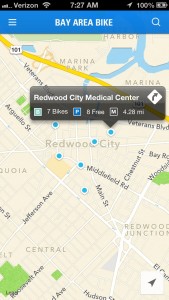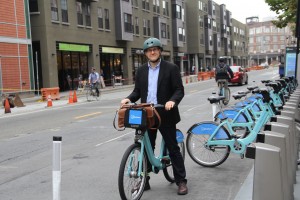[soundcloud url=”https://api.soundcloud.com/tracks/115518517″ width=”100%” height=”166″ iframe=”true” /]
The premise is appealing: For $88 a year or $9 a day, Bay Area commuters can borrow a high-tech bicycle for 30 minutes at a clip, foregoing the hassle of driving or hauling a bike on Caltrain and then locking it up.

But since its late-August debut, the Bay Area Bike Share pilot has been slow to gain traction, especially on the Peninsula. While yearly memberships increased modestly in six weeks, and casual riders nearly tripled to 6,000, new data shows daily ridership hasn’t seen the surge experienced by similar programs in New York City and Chicago.
Between Aug. 29 and Oct. 6, about 34,000 trips were taken on the 700 available Bay Area bicycles. That equates to 1.10 rides per bike per day, a slight increase from the .92 figure reported by Streetsblog after the pilot’s initial two weeks.
New York’s Citi Bike program signed up more than 60,000 members after eight weeks, with as many as 7.0 rides per bike, per day. In Chicago, 50,000 trips were made in the first three weeks of its Divvy bike share program, averaging about 3.4 rides per bike per day.
To be fair, those rollouts were in urban locations and, in New York City’s case, included thousands of bikes. The Bay Area pilot spans 50 miles, from San Francisco to San Jose, making it a rare model for bike sharing, said Bay Area Air Quality District Management spokesperson Ralph Bormann.
“It’s a different system. It’s the first in California, and the expectations are different when comparing it to New York and other locations,” he said. “We’re pleased with the results so far.”
The air quality management district did not provide data broken out by bike stations. But Bormann confirmed what others are seeing — the city stations are being used more than those on the Peninsula, where tech companies famously shuttle employees on buses and commuters who own bikes tend to use them. Besides, it’s not easy to pry suburbanites from their cars.
This creates a potential chicken-and-egg problem: Local agencies are trying to propel the pilot forward, even as stations in places like Redwood City show nearly full bike racks at times.
On top of that, the marketing budget is marginal compared with operational costs, leaving some potential users in the dark.

San Jose-based massage therapist Carey Hassinger, who commutes to Redwood City three or four times a month, said he wasn’t aware of the program, as he stood feet away from a full row of aqua blue “Bianchi-colored” bikes at the Redwood City Caltrain station.
“Maybe I’m not the brightest star in the sky, or I too often have my nose in my smartphone,” he joked. “Has there been a lot of marketing around this?”
After learning more, Hassinger concluded he liked the idea “if there are a lot of locations with bikes…but my personal preference would still be to go buy a really nice bicycle and use that.”
During weekday rush hours in downtown San Francisco, though, a different picture is painted, with commuters regularly whizzing in and out of the bike share stations near the Caltrain hub at 4th and King streets, and a few blocks away at 7th and Townsend.
Oakland resident Matthew Petty buses into the city every day and uses the bike share for the remainder of his commute. Petty said the pilot program has been an excellent experience, and has gotten him “back in the saddle.”
“Perhaps by this time next year I’ll have bought my own bike,” he said, “but then I see people who bring their bikes on the bus or train and there’s no space, and it’s really just a hassle.”
Also, “I’ve been able to get fit,” said Petty, a native of the United Kingdom.
The Bay Area Bike Share pilot is a joint effort between the air quality management district and a handful of other agencies, including the San Francisco Municipal Transportation Agency, Caltrain, both San Mateo County and Santa Clara Valley transportation authorities and the City of Redwood City. They want to improve air quality over time and ease traffic along El Camino Real, by encouraging commuters to ride bikes.
Bormann said Bay Area Bike Share has received $11.2 million in funding to date, largely through federal sources but also from partner agencies. Seventy solar-powered docking stations have been installed across five cities — San Francisco, Redwood City, Palo Alto, Mountain View and San Jose — to support the 700 bikes in rotation.
At last month’s Citizens Advisory Committee meeting for the San Mateo County Transportation Authority, some members expressed skepticism about the location of stations, specifically in Redwood City where six stations are tightly clustered in the downtown area. Then, the next nearest group of bike pods is about five miles away.

According to transcripts from the meeting, committee member Randy Hees said at the time that the program is not big enough to be highly functional. He did note, however, that he saw people taking photos in front of a docking station, “so it is capturing people’s imaginations.”
The station locations were mapped out by Alta Bike Share, a company that operates several well-known bike share systems around the country. Alta Bike Share did not respond to a request for comment.
Bormann said the program is on track to add kiosk stations and 300 more bikes by the end of the year. Ideally, the system will become self-supporting, Bormann said, with as many as 6,000 to 10,000 bikes throughout the Bay Area.
Meanwhile, the air quality management district is conducting a mass survey to determine who its current riders are and why people are (or aren’t) using it. In the future, groups of employers in the area could also sponsor bike stations in front of their buildings, which might increase the appeal for commuters — but those employers would have to put up funding for maintenance and upkeep of the bike stations.
“This is a pilot,” Bormann emphasized. “The idea is to get a lot of data right now and tweak things so that we can grow this system in a robust way.”
Listen to reporter Lauren Goode explain the story behind the story on KZSU Stanford’s “Peninsula Report” radio show with host Eliza Ridgeway:
[soundcloud url=”https://api.soundcloud.com/tracks/118130208″ width=”100%” height=”166″ iframe=”true” /]
